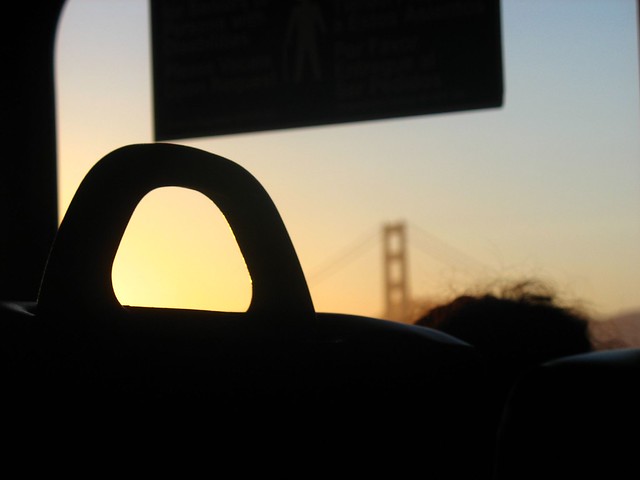 It's national Dump the Pump Day! Leave the car at home and take transit to work.
It's national Dump the Pump Day! Leave the car at home and take transit to work.
Driving to work costs you and Marin a ridiculous amount of time and money while degrading the environment. Switching to transit means you'll have time to work on the bus or ferry and don't have to worry about traffic. Switching to a bike means you can cancel that gym membership, and anytime you walk to or from a bus stop you're making yourself healthier.
This year GGT and Marin Transit have made it easy to find a way to your job without 511.org (though the app is still handy). Google Maps has integrated the two agencies into its transit directions system, so you can figure out how to get where you need to go.
If you're already at work, don't worry; just take the bus tomorrow. Let us know how your commute goes in the comments.
Marin County
- Tam Valley's Evergreen sidewalk will be built. A judge threw out a lawsuit to stop the project, arguing that because the suit had come after construction had begun it wasn't timely. Neighbors, though, have vowed to continue the fight. (IJ, @scottalonso, MV Herald)
- It's now legal to rent your home, or part of your home, for less than 30 days in Sausalito. The council voted to lift the prohibition in anticipation of the America's Cup, but don't get too comfortable. Participating homeowners need to pay for a $238 permit and collect the 12% transient occupancy tax, and the law expires in October, 2013. (Marinscope)
- Sausalito resubmitted its draft housing element to the state with only minor tweaks and a letter addressing HCD's criticism of the plan. Sausalito's plan had been rejected by the state for a number of reasons, including over reliance on second units and liveabords. (Marinscope)
- San Anselmo is pondering whether to ban chain restaurants and shops from downtown or anywhere in the town, but the existence of local chain High Tech Burrito has thrown the plans a bit of a curveball. (Patch)
- SF Public Press has a wonderful series on Plan Bay Area and smart growth in general. So far the series has tackled local resistance to Plan Bay Area, reviews Forum's conversation on the plan, and why smart growth actually is a good idea. Despite a half-bungled report on carrying capacity, the whole series is a must-read. If you can't find a dead tree copy of the quarterly around, you can either wait for the slow drip of news online or just get it hand-delivered by the postman for $4. (SF Public Press, KQED)
- Critics of Plan Bay Area ignore history when declaring Marin doesn't grow, ignore environmentalism when declaring Marin must not grow, and ignore facts when declaring it a conspiracy at the highest levels. (Pacific Sun)
- GGT's @GoldenGateBus account tweeted about a bus service disruption caused by the Pier 29 fire. Though the tweet didn't include a link to the site that actually described which stops were effected, it's a good start and hopefully a sign of things to come. Great job, GGT! (Twitter, SFGate, GGT)
- Go see West End at tomorrow's Culture Crawl from 5pm-8pm. The neighborhood's merchants see far less traffic than downtown San Rafael just over the hill, though the neighborhood is far from dull. (IJ)
- And...: An unwalkable bit of south Novato is set to become home to 12-14 affordable housing units. (NBBJ) ... County supervisors passed a $473 million budget for the year. An unallocated chunk of $22 million will be divvied up in coming weeks. (IJ) ... It looks like San Rafael will pass a budget without cutting the Street Crimes Unit. (IJ)
The Greater Marin
- Plans for a car-free Market Street are chugging along in San Francisco under the aegis of Better Market Street. The plan would close Market from Embarcadero all the way down to Octavia, improving transit travel times and pedestrian and bicycle safety. If approved, expected opening date would be 2016. (SFist)
- Apartments are booming in downtown Windsor with 1,200 units on track to open over the next five years. The rapid pace of development near its future SMART station has left some wondering whether the city can absorb such growth, and whether it even ought to allow it. (Press-Democrat)
- Sacramento's light rail now reaches its riverfront, part of a major redevelopment plan for the capital's central neighborhoods. The city's step is to get it over the river, though there's no telling when the money will come in. (Sacramento Bee)
- The next phase of the American Dreamwill not look like the last 50 years of sprawl as people finally learn what Marin knew so long ago: that the heart of a place is its downtown, not its shopping mall. (NYT)
- The problems facing cities are as old as cities themselves. Ancient Rome had traffic jams, restrictions on freight travel within the city, noise pollution, slumlords, sky-high rents and poets to document it all. (The Iris via Planetizen)
- A 10-story development in downtown Santa Rosa got another permit extension as developers continue to face financial problems. (Press-Democrat)
Got a tip? Tweet @theGreaterMarin, email thegreatermarin [at] gmail.com, or post something on Facebook.
